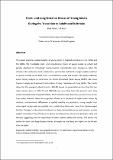Files in this item
Short- and long-distance moves of young adults during the transition to adulthood in Britain
Item metadata
| dc.contributor.author | Pelikh, Alina | |
| dc.contributor.author | Kulu, Hill | |
| dc.date.accessioned | 2019-12-21T00:36:08Z | |
| dc.date.available | 2019-12-21T00:36:08Z | |
| dc.date.issued | 2018-07 | |
| dc.identifier | 251518464 | |
| dc.identifier | c5fd9051-212a-4bc3-94d8-80f529a5c8a5 | |
| dc.identifier | 85038425009 | |
| dc.identifier | 000437840600002 | |
| dc.identifier.citation | Pelikh , A & Kulu , H 2018 , ' Short- and long-distance moves of young adults during the transition to adulthood in Britain ' , Population, Space and Place , vol. 24 , no. 5 , e2125 . https://doi.org/10.1002/psp.2125 | en |
| dc.identifier.issn | 1544-8444 | |
| dc.identifier.other | ORCID: /0000-0001-8808-0719/work/75996968 | |
| dc.identifier.uri | https://hdl.handle.net/10023/19185 | |
| dc.description | Alina Pelikh's research was supported by the Economic and Social Research Council (ES/J500094/1; PhD project: “Transition to Adulthood in Britain: The analysis of life trajectories of young adults,” the North West Doctoral Training Centre) and the University of Liverpool. This study was further supported by the Economic and Social Research Council (Grant ES/L01663X/1). | en |
| dc.description.abstract | This paper examines spatial mobility of young adults in England and Wales in the 1990s and the 2000s. We investigate short- and long-distance moves of young people by cohort and gender adjusted for individuals’ socioeconomic characteristics and changes in other life domains. We study how much employment, partnership and family changes explain variation in spatial mobility across birth cohorts and between males and females. We apply multistate event history analysis to data from the British Household Panel Survey (BHPS). We move beyond a single-event-approach and analyse moving trajectories of young adults. The results show that the youngest cohort (born in 1985-90) leaves the parental home later than the two older cohorts (born in 1974-79 and 1980-84), but once they leave the parental nest, they exhibit elevated levels of spatial mobility. We find that females leave the parental home earlier than males; however, there are no gender differences in the levels of higher-order moves. By contrast, socioeconomic differences in spatial mobility are persistent; young people from advantaged backgrounds are spatially more mobile than those who come from disadvantaged families. Changes in educational enrolment and level, partnership status and economic activity explain only little of the differences in spatial mobility across cohorts and between males and females suggesting also the importance of other motives behind the moves. The results are similar for short- and long-distance moves, although the risk levels are higher for the former than the latter. | |
| dc.format.extent | 14 | |
| dc.format.extent | 1098068 | |
| dc.language.iso | eng | |
| dc.relation.ispartof | Population, Space and Place | en |
| dc.subject | Spatial mobility | en |
| dc.subject | Young adults | en |
| dc.subject | Transition to adulthood | en |
| dc.subject | England and Wales | en |
| dc.subject | Event history analysis | en |
| dc.subject | British Household Panel Survey | en |
| dc.subject | G Geography (General) | en |
| dc.subject | H Social Sciences (General) | en |
| dc.subject | 3rd-NDAS | en |
| dc.subject | SDG 4 - Quality Education | en |
| dc.subject.lcc | G1 | en |
| dc.subject.lcc | H1 | en |
| dc.title | Short- and long-distance moves of young adults during the transition to adulthood in Britain | en |
| dc.type | Journal article | en |
| dc.contributor.sponsor | Economic & Social Research Council | en |
| dc.contributor.institution | University of St Andrews. School of Geography & Sustainable Development | en |
| dc.identifier.doi | 10.1002/psp.2125 | |
| dc.description.status | Peer reviewed | en |
| dc.date.embargoedUntil | 2019-12-21 | |
| dc.identifier.grantnumber | ES/L01663X/2 | en |
This item appears in the following Collection(s)
Items in the St Andrews Research Repository are protected by copyright, with all rights reserved, unless otherwise indicated.

